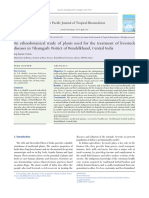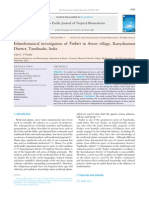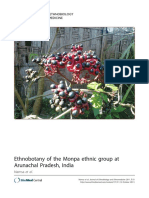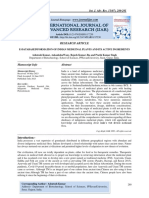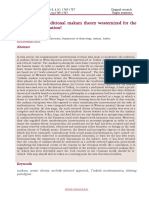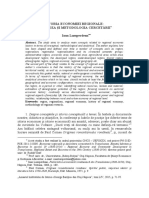Potential Medicinal Plants of Odisha Used in Rheumatism and Conservation
Potential Medicinal Plants of Odisha Used in Rheumatism and Conservation
Uploaded by
shandraCopyright:
Available Formats
Potential Medicinal Plants of Odisha Used in Rheumatism and Conservation
Potential Medicinal Plants of Odisha Used in Rheumatism and Conservation
Uploaded by
shandraOriginal Description:
Original Title
Copyright
Available Formats
Share this document
Did you find this document useful?
Is this content inappropriate?
Copyright:
Available Formats
Potential Medicinal Plants of Odisha Used in Rheumatism and Conservation
Potential Medicinal Plants of Odisha Used in Rheumatism and Conservation
Uploaded by
shandraCopyright:
Available Formats
American Journal of Ethnomedicine, 2014, Vol. 1, No.
4, 260-265
Available online at http://www.ajethno.com
American Journal of Ethnomedicine
Potential Medicinal Plants of Odisha Used in
Rheumatism and Conservation
S.P. Panda*1, H.K. Sahoo2, H.N. Subudhi3 and A.K. Sahu4
1
Odisha Biodiversity Board, RPRC Campus, Bhubaneswar-15, India
Vasundhara, Bhubaneswar, India
3
Central Rice Research Institute, Cuttack, India
4
SPMU, ICZMP Odisha, 108 Surya Nagar, Bhubaneswar, India
2
ABSTRACT
Odisha, one of the coastal states of Indian sub-continent is endowed with potential
medicinal plants owing to its peculiar topography and geographically distributed
various microclimatic locations. But due attention was not paid to explore these
life forms and alkaloids present in them having need specific chemical
constituents. These natural resources are neither being properly exploited and nor
even utilized their economic benefits from these Godly life forms. Due to
anthropogenic over exploitation, many of such life forms are on the verge of
being extinct or rare or vulnerable etc. It is high time to get rid of this ignorance
and to plan for an optimal utilization of our nature given resources. To take such
an endeavour, this paper deals with 68 medicinal plant species having significant
role in curing rheumatism under 62 genera and belonging to 37 families collected
from various parts of the state. The species are arranged alphabetically with their
family, vernacular name, usable part (in table -1). Concurrently some
conservational strategies have also been suggested before it becomes endanger or
rare or extinct.
Keywords- Medicinal plants, Odisha, Rheumatism, Conservation.
INTRODUCTION
Odisha is situated in the east coast of the
Bay of Bengal of the Indian sub-continent
and lies in between 17 48-22 94N
latitude and 8124 - 8729 E longitude. It
is the treasure house of healing herbs, which
are being used in Indian system of medicine
viz., Auyrveda, Siddha and Unani. However,
owing to complex topography and variety of
microclimatic parameters, several life forms
are not coming to the forefront of common
people, out of which the plants of immense
medicinal significance deserve special
mention.
The mountainous forests of the
Deomali hills, Gandhamardan hill range,
Mahendragiri hills, Niyamagiri hill range,
Malyagiri hills, Similipal Biosphere Reserve
and coastal forests including the mangroves
and their associates have high degree of
biological diversity as well as grand
repository of potential medicinal plants.
These forests have been the source of
www.ajethno.com
American Journal of Ethnomedicine ________________________________________ ISSN: 2348-9502
invaluable medicinal plants since the time
human being realized the preventive and
curative properties of plants and started
using them for health care for them as well
as for their pets. Many of these areas are
ethnobotanically
resourceful.
The
aboriginals depend on the forests as well as
forest resources to cater their needs like
food, cloth, shelter and medicine. The tribal
people are not very willing to disclose their
knowledge about the uses of the plant/ plant
parts being important curative resources
except for some commonly useful medicinal
properties. In general, they maintain secrecy
about the use of certain medicinal plants
with a belief that the medicines will lose
their healing power, if too many heads know
about them.
About 400 plants are used in usual
preparation of Ayurvedic, Unani, Siddha
and tribal medicine. As far as the
information available, these preparations are
about 75% from tropical and 25% from
temperate forests. Out of which, 30% of
these preparations are from roots, 14% from
bark, 16% whole plants, 5% from flowers,
10% from fruits, 6% from leaves, 7% from
seeds, 3% from wood, 4% from rhizomes
and 6% from stems but only less than 20%
(including spices) such plants are
cultivated1,2.
In spite of such a resourceful utility,
very limited study have been done by Sahoo,
Saxena et Dutta, Subudhi et Choudhury on
the ethnobotany and ethnomedicine of the
state6,8,10.
METHODOLOGY
Regular field trips were carried out
to different resourceful areas of important
forests of the state in order to collect
information regarding the distribution
pattern and flowering time of the plants.
Considering the important medicinal utility,
the plants were collected and identified in
consultation with the regional floras4,7 and
Page 260-265
monographs and preserved in the herbarium
of the P.G. Department of Botany, Utkal
University, Bhubaneswar. The part of the
plants used to treat rheumatism and over all
information of uses was gathered by the
method of ethnobotanical investigation. The
authenticity of the medicinal importance of
the species were carefully examined by the
standard literatures1,3,5,8,9,11.
During the present exploration, only
medicinal plant species having broad
spectrum of use in healing rheumatism were
considered. In the present treatment, habit,
species under genera along with their
family, vernacular name, where ever
available and usable parts with medicinal
utility etc. were given. The families are
arranged alphabetically and the species are
also represented alphabetically under each
family. Besides, some conservational
strategies have also been provided for the
medicinal plants for posterity.
Systematic analysis
A total of 68 angiosperms having
rheumatism healing properties and used by
the local inhabitants especially the tribals of
the forest fringe villages were collected
belonging to 62 genera under 37 families
(table-1). Acanthaceae is the first dominant
family followed by Caesalpiniaceae,
Fabaceae and Malvaceae (Fig-1). It indicates
that maximum species of Acanthaceae have
been utilized in healing rheumatism. Out of
37 families, 25 are monotypic i.e.
represented by both single genus and species
and 35 are dicot families representing 66
dicot species whereas 2 monocot species
under 2 monocot families.
CONSERVATION
From the time immemorial, Odisha
was endowed with potential medicinal
plants. Recently due to the increasing
popularity of Ayurvedic drugs a large
number of drug manufacturing companies
American Journal of Ethnomedicine ________________________________________ ISSN: 2348-9502
have been established in the country. As it is
found in the practice, many of the medicinal
plant collectors supply a large scale of
plants/plant parts from the remote forests to
the factories without knowing the status and
economic importance of these plants. Now,
the pressure on the forests in general and
medicinal plants found in the forests in
particular has been increased significantly.
So, the plants are over-exploited leading in
to extinction of the species. Shifting
cultivation, establishment of industries, clear
off of forest lands for human settlement and
illegal cutting of tree species to cater various
needs have accelerated the process of
dwindling of many rare and endangered
species.
Odisha state has a great potential to
produce large quantity of medicinal products
as it has wide range of eco-climatic regions.
Although quite a good number of medicinal
plants have been wiped away from the state
due to the operation of various biotic factors
coupled with other abiotic reasons, still
Odisha is a grand repository of many
indigenous medicinal plants. Hence,
appropriate protection and conservational
steps are the need of the hour. To conserve
the medicinal and aromatic plants, the first
step would to prepare a status report on
different aspects related to medicinal plant
resources in Odisha. These life forms can be
conserved by developing medicinal gardens
in educational and research institutions in
general and Ayurvedic Hospitals in
particular. Many indigenous as well as
exotic species that were brought from
various regions need to be conserved in the
herbal gardens by government sponsorship.
Modern technology can be utilized such as
cryo-preservation along with traditional field
gene bank process both in in-situ and ex-situ
preservation practices.
In order to promote the cultivation
and judicious utilization of medicinal plants,
farmers as well as the tribals needs to be
trained, educated with the various agroPage 260-265
techniques, processing and marketing of
medicinal and aromatic plants. It is quite
certain that with a whole hearted effort from
the government sector, this may be
successful in tribal areas, which are still
depending on the collection and selling of
non-timber minor forest products for their
livelihood.
CONCLUSION
In India, the country people have
their own traditional medical knowledge to
cure different diseases. Furthermore we
found that rheumatism is linked with old age
people and this age group is quite
experienced in due course of time and each
have their method of preparation relating to
their traditional origin. The traditional
wisdom, embedded with strong cultural
relations with nature and natural resources
reconcile between conservation and
medicinal plant extractions.
ACKNOWLEDGMENT
Indebted thanks are due to the Prof.
and Head, P.G. Department of Botany, Utkal
University, Bhubaneswar for providing
necessary library and laboratory facilities to
carry out the work.
REFERENCES
1. Agarwal YS, Ghosh B. Drug plants of India
(Root Drugs). New Delhi; Kalyani
Publishers, 1985.
2. Annomymous. Amruth. FRLHT, Bangalore;
August 1977; 10.
3. Chopra RN, Nayar SL, Chopra IC. Glossary
of Indian Medicinal Plants. CSIR, New
Delhi; 1956.
4. Haines HH. The Botany of Bihar and Orissa.
6 parts, Landon; 1921-25.
5. Kirtikar KR, Basu BD. Indian Medicinal
Plants. Vol (1-2). ICMR, New Delhi; 1935.
6. Sahoo AK. Plant Resources of Kandhamal
district (Odisha) some suggestion to develop
American Journal of Ethnomedicine ________________________________________ ISSN: 2348-9502
cottage industries in tribal locatlities. Orissa
Review 1986; 43 (4) 39-44.
7. Saxena HO, Brahman M. The Flora of
Orissa. Vol. (1-4), Odisha Forest
Development Corporation; Bhubaneswar;
1994-96.
8. Saxena HO, Dutta PK. Studies on the
ethnobotany of Orissa. Bull. Bot. Surv. India
1975; 17 (1-4) 124-131.
9. Stayavati GV, Gupta AK, Tandon N.
Medicinal plants of India. Vol. (1-2), ICMR,
New Delhi; 1987.
10. Subudhi
HN,
Choudhury
BP.
Ethnobotanical studies in the district of
Kandhamal (Orissa-1). Bio-Sci. Res. Bull.
1985; 1 (1-2): 26-32.
11. Warrier PK, Nambiar VPK, Ramankutty C.
Indian Medicinal Plants (Vol.1-5), Madras;
Orient Longman Ltd.; 1994-96.
Table 1. Ethnomedicinal plants used to treat rheumatism
S. No.
Name of the species
1.
2.
Acanthus ilicifolius L.
Achyranthes aspera L.
Hygrophila auriculata
(Schum.) Heine
Justicia adhatoda L.
Thunbergia fragrans Roxb.
Cerbera odollam Gaertn.
Holarrhena pubescens
(Buch-Ham.) Wall. ex G.
Don
Ichnocarpus frutescens (L.)
R. Br.
Calotropis gigantea R. Br.
Cryptolepis buchananii
Roem. & Schult.
Pergularia daemia (Forssk.)
Chiov.
Guizotia abyssinica (L.f.)
Cass.
3.
4.
5.
6.
7.
8.
9.
10.
11.
12.
13.
Bombax ceiba L.
Parts
used
Lv
Rt, S
Lv, Rt, S,
WH
Rt
Rt, Lv
Fr
Bk
Family
Habit
Vernacular name
Acanthaceae
Acanthaceae
Under-shrub
Herb
Harkach
Apamaranga
Acanthaceae
Herb / Sub-shrub
Koilekha/Katathua
Acanthaceae
Acanthaceae
Apocyanaceae
Shrub
Twiner
Tree
Basanga
Chakrakedar
Paniamba
Apocyanaceae
Shrub
Pitakorwa
Rt, Lv,
WH
Lv
Rt, Lv,
WH
Apocyanaceae
Climbing shrub
Soyamnoi/syamalata
Ascelpiadaceae
Shrub
Arakha
Asclepiadaceae
Twining shrub
Dudhimal/Karanta
Lv
Ascelpiadaceae
Climber
Hunturi/Phala Kantaka
S oil
Asteraceae
Herb
Tilo
Rt, Lv
HW
Bombacaceae
Tree
Semeli
Trichodesma indicum (L.) R.
Br.
Bauhinia purpurea L.
Caesalpinia bonduc (L.)
Roxb.
WP
Boraginaceae
Herb
Raktokoi
Lv, Rt
Caesalpiniaceae
Tree
Barada
Caesalpiniaceae
Climber
Gilogila
17.
Caesalpinia crista L.
Fr
Caesalpiniceae
18.
19.
20.
Cassia fistula L.
Cassia tora L.
Celastrus paniculatus Willd.
Ipomoea pes-caprae (L.) R.
Br.
Fr
Lv
S, Lv
Tb
14.
15.
16.
21.
Page 260-265
Caesalpiniaceae
Caesalpiniaceae
Celastraceae
Climber/ Thorny
scrambling shrub
Deciduous Tree
Under-shrub
Climbing shrub
Sunari
Chakunda
Karsano/Malkangni
Convolvulaceae
Creeping herb
Kansarinata
Putikaranja
American Journal of Ethnomedicine ________________________________________ ISSN: 2348-9502
Rt
Convolvulaceae
23.
Operculina turpethum (L.)
Silva-mano
Momordica charantia L.
Fr, S
Cucurbitaceae
Climber/ Large
climbing shrub
Climber
24.
Dioscorea pentaphylla L.
Tb
Dioscoreaceae
Twining herb
Pittalokanda/Kantaalu
25.
26.
27.
28.
29.
Acalypha indica L.
Jatropha curcas L.
Jatropha glandulifera Roxb.
Jatropha gossypifolia L.
Abrus precatorius L.
Derris scandens (Roxb.)
Benth.
Derris trifoliata Lour.
Pongamia pinnata (L.)
Pierre
WP
Oil
S
Oil
Rt, S
Euphorbiaceae
Euphorbiaceae
Euphorbiaceae
Euphorbiaceae
Fabaceae
Herb
Shrub
Shrub
Shrub
Twining shrub
Koilekha
Bamprigada/Chandrajyoti
Jalijalika
Baigoba
Kaincha
Lv
Fabaceae
Climbing shrub
Mohagano
S oil
Fabaceae
Climbing shrub
Swanlata
Lv, S , Bk
Fabaceae
Tree
Karanja
Rt
Fabaceae
Climber / Liana
with large
tuberous root
Bhuinkakharu
22.
30.
31.
32.
33.
Pueraria tuberosa (Willd.)
DC.
Dudholoma/Nisoth
Kalara
Flacourtia indica (Burm.f.)
Merr.
Ocimum gratissimum L.
Allium sativum L.
Asparagus racemosus
Willd.
Lv
Flacourtiaceae
Shrub
Bhainchakoli
Lv
Rb
Lamiaceae
Liliaceae
Shrub
Herb
Bantulsi
Khrubeli
Rt
Liliaceae
Herb
Satabari
38.
Abutilon indicum (L.) Sweet
Lv
Malvaceae
39.
40.
41.
42.
Pavonia odorata Willd.
Sida cordifolia L.
Sida rhombifolia L.
Melia azadirach L.
WH
WH
WH
Lv, Fr, S
Malvaceae
Malvaceae
Malvaceae
Meliaceae
43.
Cocculus hirsutus (L.) Diels
Rt , Lv
Menispermaceae
44.
45.
Ficus benghalensis L.
Moringa oleifera Lam.
Bk
Lv, Fr, Oil
Moraceae
Moringaceae
46.
Boerrhavia diffusa L.
WH
Nyctaginaceae
47.
Nyctanthes arbortristis L.
Vanda tessellata (Roxb.)
Hook. ex G. Don
Pandanus fascicularis Lam.
Argemone mexicana L.
Sesamum indicum L.
Hemidesmus indicus (L.) R.
Lv, Fl
Oleaceae
Under-shrub/
short pubescent
shrub
Herb
Herb
Herb
Tree
Climber/Scandan
t Shrub
Tree
Tree
Herb / Common
weed of sandy
tracts/ waste
lands
Tree
Rt
Orchidaceae
Herb
Malang
Oil
WP
S
Rt
Pandanaceae
Papaveraceae
Pedaliaceae
Periplocaceae
Shrub
Annual Herb
Herb
Twining / under
Kia
Agara
Rasi
Anantamula
34.
35.
36.
37.
48.
49.
50.
51.
52.
Page 260-265
Pedipedica
Kurubeli
Bisiripi
Bajramuli
Mahalimba
Dahdahiya/Patalagarudi
Bara
Sajana
Goudapuruni/Punarnava
Gangaseoli
American Journal of Ethnomedicine ________________________________________ ISSN: 2348-9502
53.
54.
Br.
Piper longum L.
Plumbago zeylancia L.
55.
Ventilago denticulata Willd.
56.
Murraya paniculata (L.)
Jack
57.
Cardiospermum
helicacabum L.
58.
59.
60.
61.
62.
63.
64.
65.
66.
67.
Fr
Rt
Rt, Fl,
WH, Bk,
St, S
Piperaceae
Plumbaginaceae
shrub
Creeping herb
Under shrub
Pippali
Chitaparu
Rhamnaceae
Woody climber
Pittoli
Lv / Rt Bk
Rutaceae
Shrub/ Small tree
Banamallika
Lv, S
Sapindaceae
Madhuca indica Gmel.
Ailanthus excelsa Roxb.
Smilax perfoliata Lour.
Smilax zeylanica L.
Datura innoxia Mill.
Datura metel L.
Nicotiana tobaccum L.
Solanum virginianum L.
Withania somnifera (L.)
Dunal
Stachytarpheta jamaicensis
(L.) Vahl
S
Lv
Rt
Rt
Lv
Lv
Tabacco
Lv
Sapotaceae
Simaroubaceae
Smilacaceae
Smilacaceae
Solanceae
Solanaceae
Solanaceae
Solanaceae
Climbing herb
with tendrillar
hooks
Tree
Tree
Climbing herb
Climber
Shrub
Shrub
Herb
Herb
Rt, Lv
Solanaceae
Under Shrub
Ashwagandha
WH
Verbenaceae
Herb
Jalijalika
Vitex negundo L.
Lv
Verbenaceae
Shrub
(Quadrangular)
Begunia
68.
Mayajala/Kanphuta
Mahula
Mahalimba
Mothuri
Mutri
Duddura
Kala dudura
Tamaku
Ankaranti
Key to the part used: Lv: Leaves, Rt: Root, S: Seed, WH: Heart wood, Fr: Fruit, Bk: Bark, S.
oil: Seed oil, Tb: Tuber, WP: Whole plant, Fl : Flower, Rb: Bulb, St: Stem
6
5
4
3
2
1
No. of Genera
Acanthaceae
Apocyanaceae
Ascelpiadaceae
Asteraceae
Bombacaceae
Boraginaceae
Caesalpiniaceae
Celastraceae
Convolvulaceae
Cucurbitaceae
Dioscoreaceae
Euphorbiaceae
Fabaceae
Flacourtiaceae
Lamiaceae
Liliaceae
Malvaceae
Menispermaceae
Moraceae
Moringaceae
Nyctaginaceae
Oleaceae
Orchidaceae
Pandanaceae
Papaveraceae
Pedaliaceae
Periplocaceae
Piperaceae
Plumbaginaceae
Rhamnaceae
Rutaceae
Sapindaceae
Sapotaceae
Simaroubaceae
Smilacaceae
Solanaceae
Verbenaceae
Figure 1. Distribution of genera and species under families
Page 260-265
No. of Species
You might also like
- Digital: The Energies of LoveDocument4 pagesDigital: The Energies of Loveadriviana@No ratings yet
- Stephen Toulmin, The Tyranny of PrincipleDocument10 pagesStephen Toulmin, The Tyranny of PrinciplepbfriedmanNo ratings yet
- Herbs of Valley of FlowerDocument5 pagesHerbs of Valley of FlowerbharatNo ratings yet
- Wild Edible Plants & It's UsesDocument12 pagesWild Edible Plants & It's UsesIdrees KhanNo ratings yet
- Recent Perspectives On Impact of Ethnobotany in India: A ReviewDocument4 pagesRecent Perspectives On Impact of Ethnobotany in India: A Reviewarun shuklaNo ratings yet
- N Ethnobotanical Study of Plants Used For The Treatment of Livestock Diseases in Ikamgarh Istrict of Undelkhand, Entral NdiaDocument8 pagesN Ethnobotanical Study of Plants Used For The Treatment of Livestock Diseases in Ikamgarh Istrict of Undelkhand, Entral NdiaJitesh Kumar MaharanaNo ratings yet
- Ethno Medicinal Uses of PlantsDocument4 pagesEthno Medicinal Uses of PlantsSADasNo ratings yet
- VrikshaDocument17 pagesVrikshaKishore Khudabadi100% (1)
- Medicinal Plants of Rural India: A Review of Use by Indian FolksDocument20 pagesMedicinal Plants of Rural India: A Review of Use by Indian FolksSanjiv KubalNo ratings yet
- Ethnomedicinal Plants of Sivasagar District of Assam, IndiaDocument19 pagesEthnomedicinal Plants of Sivasagar District of Assam, IndiaUttam NathNo ratings yet
- Ethnobotanical Study On Medicinal Plants Used by The Local Communities in Achanakmar Amarkantak Biosphere Reserve, Central IndiaDocument11 pagesEthnobotanical Study On Medicinal Plants Used by The Local Communities in Achanakmar Amarkantak Biosphere Reserve, Central IndiaGlobal Research and Development ServicesNo ratings yet
- Amjad Asian Pac J Trop Biomed 2015 5 (4) 292-299 PDFDocument8 pagesAmjad Asian Pac J Trop Biomed 2015 5 (4) 292-299 PDFSebastian Orjuela ForeroNo ratings yet
- New SDocument18 pagesNew Sessy_susantiNo ratings yet
- Wild Fruits 2019Document10 pagesWild Fruits 2019mariamanzoor530No ratings yet
- Malvaceae Family Medicinal PlantsDocument66 pagesMalvaceae Family Medicinal PlantsSweeti MandalNo ratings yet
- Medicinal Plants of Khasi HillsDocument6 pagesMedicinal Plants of Khasi Hillsno1dubakoorNo ratings yet
- KaithonniDocument8 pagesKaithonniJoshua JohnsonNo ratings yet
- Medicinal PlantsDocument13 pagesMedicinal PlantsSukriti SinghNo ratings yet
- 4REPORTDocument38 pages4REPORTw3 aviNo ratings yet
- Multan's Medicinal PlantsDocument5 pagesMultan's Medicinal PlantsSBKIANchemistNo ratings yet
- 4REPORTDocument38 pages4REPORTw3 aviNo ratings yet
- Medicinal PlantsDocument7 pagesMedicinal PlantsamirabuttNo ratings yet
- Biodiversity of Medicinal and Aromatic Plants Found in OdishaDocument18 pagesBiodiversity of Medicinal and Aromatic Plants Found in OdishaScorpion official gamingNo ratings yet
- 170 - 058 - Conservation of Medicinal Plants in BangladeshDocument22 pages170 - 058 - Conservation of Medicinal Plants in BangladeshEdward PittsNo ratings yet
- Biodiversity in Wild Vegetables of Konkan Region - MaharashtraDocument16 pagesBiodiversity in Wild Vegetables of Konkan Region - MaharashtraThiên ĐịaNo ratings yet
- Role of Plant Taxonomy and Ethno-Botany in Advancing Research On Medicinal Plants in IndiaDocument12 pagesRole of Plant Taxonomy and Ethno-Botany in Advancing Research On Medicinal Plants in IndiaDr. Santosh KumarNo ratings yet
- Folk Herbal Medicines Used by The Meena CommunityDocument14 pagesFolk Herbal Medicines Used by The Meena CommunityYousuf AdamNo ratings yet
- 5 2 15 251Document7 pages5 2 15 251rahulshukla203No ratings yet
- Ethnophytomedicines For Treatment of VariousDocument12 pagesEthnophytomedicines For Treatment of VariousShahNaveedNo ratings yet
- 311s 1Document87 pages311s 1nomanjamilNo ratings yet
- Speech On Medicinal Plants at KoraputDocument8 pagesSpeech On Medicinal Plants at KoraputShikha PeriyaNo ratings yet
- Wild Medicinal Plants of Umtasoar Range Under Nonghkyllem Reserve Forest, Nongpoh, Meghalaya, India and Their Traditional Usage by Khasi Tribe - IDocument10 pagesWild Medicinal Plants of Umtasoar Range Under Nonghkyllem Reserve Forest, Nongpoh, Meghalaya, India and Their Traditional Usage by Khasi Tribe - ISujith KuttanNo ratings yet
- Traditional Plant Remedies From Bungus Valley of District Kupwara KashmirDocument6 pagesTraditional Plant Remedies From Bungus Valley of District Kupwara KashmirInternational Journal of Innovative Science and Research Technology100% (2)
- R A Ethnomedicinal Plants Used by Korwa Tribe of Korba District, Chhattisgarh IndiaDocument4 pagesR A Ethnomedicinal Plants Used by Korwa Tribe of Korba District, Chhattisgarh IndiaSandeepNo ratings yet
- 1101-Article Text-1937-1-10-20180709Document17 pages1101-Article Text-1937-1-10-20180709Kanti PatelNo ratings yet
- BK Medicinal PlantsDocument307 pagesBK Medicinal PlantsАкиф РзайевNo ratings yet
- 11 1 PDFDocument19 pages11 1 PDFSruthi KarasalaNo ratings yet
- Publikasi 15 (4) Agustus 2023 - Pharmacognosy JournalDocument6 pagesPublikasi 15 (4) Agustus 2023 - Pharmacognosy JournalDharma ShantiniNo ratings yet
- Photo Profile: Saraca Asoca (Roxb.) W.J. de WildeDocument4 pagesPhoto Profile: Saraca Asoca (Roxb.) W.J. de WildePramba Kumar AhujaNo ratings yet
- Wild Fruits of Uttarakhand (India) - Ethnobotanical and Medicinal Uses - MedCrave OnlineDocument10 pagesWild Fruits of Uttarakhand (India) - Ethnobotanical and Medicinal Uses - MedCrave OnlineSanjeet Kumar SharmaNo ratings yet
- Reenu AgarwalDocument3 pagesReenu AgarwalReenu AgarwalNo ratings yet
- Role of Ethnomedicobotanical Survey in Advancement of AyurvedaDocument5 pagesRole of Ethnomedicobotanical Survey in Advancement of AyurvedaRaghuNo ratings yet
- NAMSA Nima D., & Al. - Ethnobotany of The Monpa Ethnic Group at Arunachal Pradesh India - 2011Document15 pagesNAMSA Nima D., & Al. - Ethnobotany of The Monpa Ethnic Group at Arunachal Pradesh India - 2011ninkasi1No ratings yet
- Chatterjee 3022024 JOBARI12133Document13 pagesChatterjee 3022024 JOBARI12133Annalakshmi ChatterjeeNo ratings yet
- Ethno-Veterinary Medicinal Plants of Chail ValleyDocument7 pagesEthno-Veterinary Medicinal Plants of Chail ValleyOpenaccess Research paperNo ratings yet
- Potential Medicinal Plants Used by The Tribal of Deogarh District, Orissa, IndiaDocument9 pagesPotential Medicinal Plants Used by The Tribal of Deogarh District, Orissa, IndiaB Narendra BabuNo ratings yet
- Traditional Uses of Medicinal Plants Used by Indigenous Communities For Veterinary Practices at Bajaur Agency, PakistanDocument18 pagesTraditional Uses of Medicinal Plants Used by Indigenous Communities For Veterinary Practices at Bajaur Agency, PakistanUSMANNo ratings yet
- Envis Newsletter Latest Apr11Document16 pagesEnvis Newsletter Latest Apr11Pramba Kumar AhujaNo ratings yet
- Rural Communities On Ethno Medicinal Plants Uses and Their Conservation 2167 0412 S3 E003Document2 pagesRural Communities On Ethno Medicinal Plants Uses and Their Conservation 2167 0412 S3 E003Rabeea NasirNo ratings yet
- Ethnobotany of Irular Tribes in Redhills TamilnaduDocument4 pagesEthnobotany of Irular Tribes in Redhills TamilnaduPrabu GkNo ratings yet
- Asian Herbs - and Their Wondrous Health-Giving Properties - Ahluwalia, Sudhir (Ahluwalia, Sudhir) - 2020 - UNKNOWN - Anna's ArchiveDocument287 pagesAsian Herbs - and Their Wondrous Health-Giving Properties - Ahluwalia, Sudhir (Ahluwalia, Sudhir) - 2020 - UNKNOWN - Anna's ArchiveShivam Vishwa100% (2)
- Ethanobotanical Study of Less Known Wild Edible Plants of Hakki Pikki Tribes of Angadihalli, Hassan District, KarnatakaDocument7 pagesEthanobotanical Study of Less Known Wild Edible Plants of Hakki Pikki Tribes of Angadihalli, Hassan District, KarnatakaDingo PingoNo ratings yet
- E-Databaseinformation of Indian Medicinal Plants and Its Active IngredientsDocument12 pagesE-Databaseinformation of Indian Medicinal Plants and Its Active IngredientsIJAR JOURNALNo ratings yet
- Study of Plant Biodiversity of West Singhbhum District of Jharkhand, India and Its Medicinal UsesDocument8 pagesStudy of Plant Biodiversity of West Singhbhum District of Jharkhand, India and Its Medicinal UsesEditor IJTSRDNo ratings yet
- ResearchPaper GJBBDocument6 pagesResearchPaper GJBBAryan MewaraNo ratings yet
- Research Paper - Wild Edible PlantsDocument6 pagesResearch Paper - Wild Edible PlantsAnnalakshmi ChatterjeeNo ratings yet
- WildFruit FoodSecurityPaperReprintDocument19 pagesWildFruit FoodSecurityPaperReprintcollege of forestry examination cellNo ratings yet
- 1746 4269 2 14 PDFDocument8 pages1746 4269 2 14 PDFAhmad Yar SukheraNo ratings yet
- Ethno-Medicinal Assessment of Some Selected Wild Edible Fruits and Vegetables of Lesser-Himalayas, PakistanDocument8 pagesEthno-Medicinal Assessment of Some Selected Wild Edible Fruits and Vegetables of Lesser-Himalayas, PakistanAbdul SamadNo ratings yet
- Current Status and Future Strategy For Development of Medicinal Plants Sector in Uttaranchal, India PDFDocument9 pagesCurrent Status and Future Strategy For Development of Medicinal Plants Sector in Uttaranchal, India PDFAmit RoyNo ratings yet
- Altos g330 Mk2 Installation Configuration GuideDocument100 pagesAltos g330 Mk2 Installation Configuration GuideRahul DekaNo ratings yet
- How Was The Traditional Makam Theory Wes PDFDocument19 pagesHow Was The Traditional Makam Theory Wes PDFVictor Navarro Garcia100% (2)
- Intel ArchitectureDocument125 pagesIntel ArchitecturejustinmathewNo ratings yet
- Bar Charts by SlidesgoDocument33 pagesBar Charts by SlidesgoCamilo RamirezNo ratings yet
- Parle ADocument4 pagesParle Aaspirantsj2k22No ratings yet
- 04 PDFDocument25 pages04 PDFAna Maria NitaNo ratings yet
- Sekolah Rendah Lambak KananDocument8 pagesSekolah Rendah Lambak KananHnD@hotcouple.com100% (2)
- Manual para Detector de Metales Thermo Scientific (Thermo Scientific APEX Metal Detector User's Guide)Document442 pagesManual para Detector de Metales Thermo Scientific (Thermo Scientific APEX Metal Detector User's Guide)Ronald AlvaradoNo ratings yet
- Newsletter Forts of MumbaiDocument20 pagesNewsletter Forts of MumbaiObserver Research Foundation MumbaiNo ratings yet
- Chapter 6 - Developing Device DriversDocument70 pagesChapter 6 - Developing Device DriversSunil PaiNo ratings yet
- CH Muhammad Bilal Riaz PDFDocument1 pageCH Muhammad Bilal Riaz PDFbilal janiNo ratings yet
- Gerunds and InfinitivesDocument8 pagesGerunds and InfinitivesYsamar SanchezNo ratings yet
- Hospital Como Campo de Práticas: Revisão Integrativa Da Literatura e A Terapia OcupacionalDocument9 pagesHospital Como Campo de Práticas: Revisão Integrativa Da Literatura e A Terapia OcupacionalLeandroAlvesNo ratings yet
- Sql-Backtrack For Sybase: System Consultant ManagerDocument28 pagesSql-Backtrack For Sybase: System Consultant ManagerManish SarkarNo ratings yet
- SpectraMax I3x MultiMode Microplate Reader BrochureDocument8 pagesSpectraMax I3x MultiMode Microplate Reader BrochurezeljkopopovicNo ratings yet
- Gas TurbineDocument34 pagesGas Turbinewholenumber100% (2)
- Autoregressive Conditional HeteroskedasticityDocument9 pagesAutoregressive Conditional HeteroskedasticityjuliusNo ratings yet
- Sses Melc Math g1 To g6 TCSD 1Document60 pagesSses Melc Math g1 To g6 TCSD 1GRACE PELOBELLONo ratings yet
- Usa LabsDocument162 pagesUsa Labspurnima4uonlyNo ratings yet
- Lesson Matchup Singapore Math 1a and Rod and Staff Math 1Document14 pagesLesson Matchup Singapore Math 1a and Rod and Staff Math 1roh009No ratings yet
- Peters ResumeDocument2 pagesPeters Resumeapi-320084026No ratings yet
- Java SwingDocument7 pagesJava SwingriteshyaaraaNo ratings yet
- Django Rest Auth LatestDocument19 pagesDjango Rest Auth LatestSuhailNo ratings yet
- Statistics Probability11 q3 Week3 v4Document10 pagesStatistics Probability11 q3 Week3 v4revamay286No ratings yet
- Technology of Dynamic Kill Drilling For Drilling in The Superficial Layer of Deepwater PDFDocument6 pagesTechnology of Dynamic Kill Drilling For Drilling in The Superficial Layer of Deepwater PDFNA NANo ratings yet
- Lesson Plan - Multiple and Factors - PPT - V 3Document35 pagesLesson Plan - Multiple and Factors - PPT - V 3kavitagrover5718No ratings yet
- GFDGKHJDFLDocument2 pagesGFDGKHJDFLJM MlbnnNo ratings yet
- 2021 - 1G3 EL - EOY HOMEWORK P2 - QuestionsDocument4 pages2021 - 1G3 EL - EOY HOMEWORK P2 - QuestionsMani Kumaresan Janarthanavel (Scss)No ratings yet





